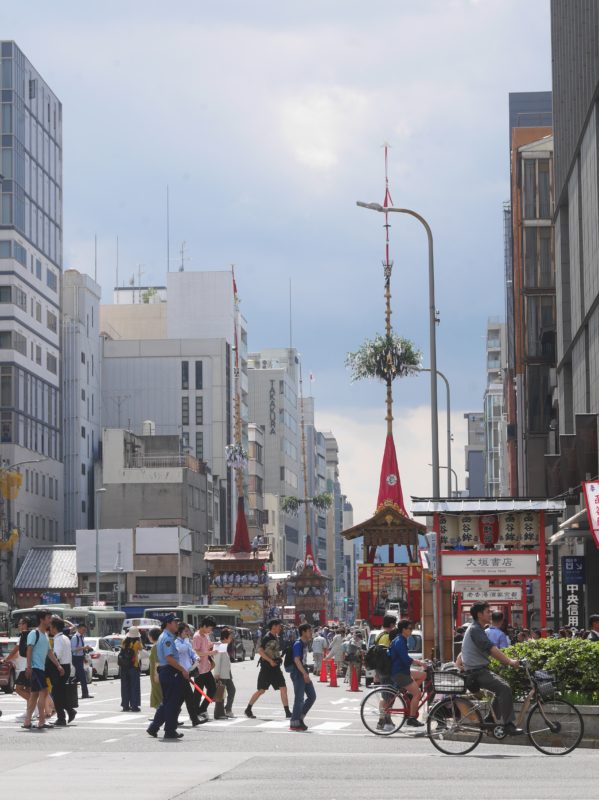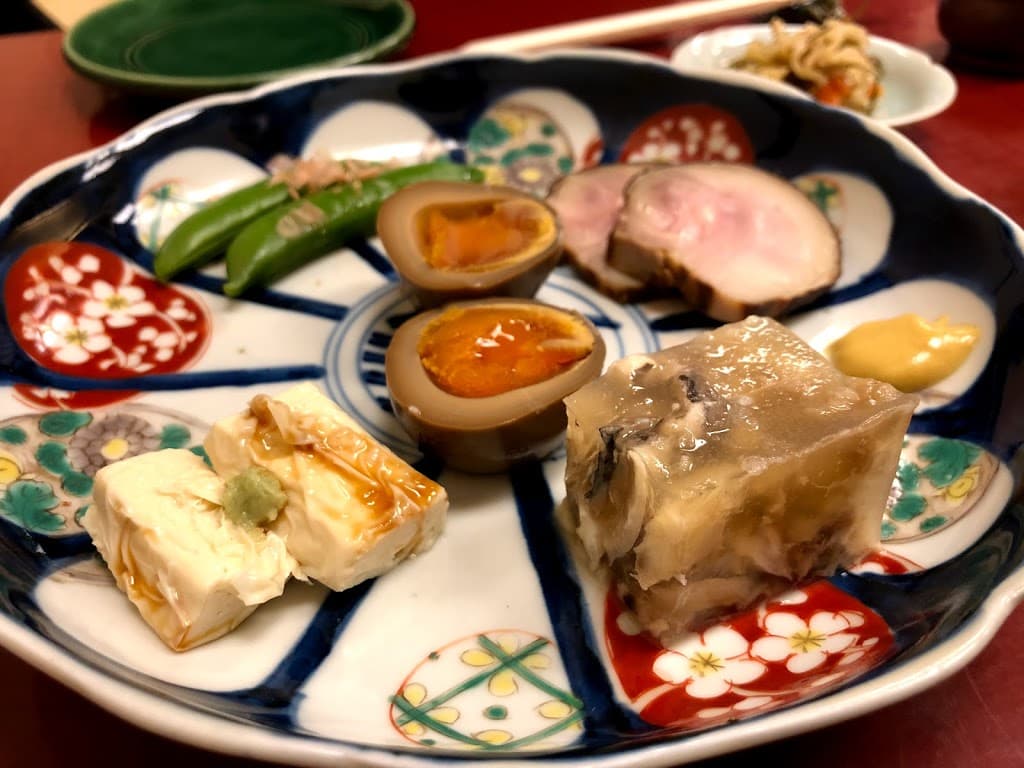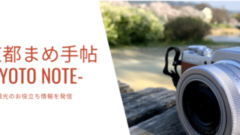This article introduces the schedule, outline (history), and highlights of the Gion Festival.
- I want to know about the highlights of the Gion Festival.
- I want to know the schedule of the Gion Festival and what I can do.
- I want to ride the Yamaboko floats!
- I want to ride the Yamaboko floats!
- Where is the best place to watch the procession?
- I want to know about the Gion Festival in 2022
- I want to know what the Gion Festival has been like in the past (from 2019)
Please refer to the following information.
- Gion Festival(Gion Matsuri:祇園祭)
- Schedule Of Gion Festival
- Highlights of the Gion Festival
- Report on the Gion Festival in July 2019 (with photos)
- July 10-14 Yamaboko erection (Mae-matsuri)
- July 12-13: Beginning of pulling and carrying of floats and yama (Mae-matsuri)
- July 13: Naginatahoko Chigo Shasan(長刀鉾稚児社参)
- July 14-16 Yoiyama
- July 17: Yamaboko Junko (float parade) at the Mae-matsuri Festival
- July 18-21 Yamahokotate (Ato Matsuri)
- July 24: Yamaboko Junko (halberd procession) at the Ato Matsuri
- Thoughts on the 2019 Gion Festival
Gion Festival(Gion Matsuri:祇園祭)
The Gion Festival is one of the three major festivals in Japan and a summer tradition in Kyoto, a festival of Yasaka Shrine with a tradition and history of over 1,000 years.
During the festival, visitors can hear “Konchi-kichin♪” sounds and musical accompaniment played by drums and flutes as they walk through the streets of Kyoto.
During this period, many people visit Kyoto, not only from Japan but also from overseas, and the Yamahoko Junko and Yoiyama festivals in particular are the busiest.
The Yamaboko Junko, which is considered the highlight of the festival, was designated as an Important Intangible Cultural Property of Japan in 1979 and was further registered as an Intangible Cultural Heritage of Japan by the United Nations Educational, Scientific and Cultural Organization (UNESCO) in 2009.
The origin of this festival is said to be the Gion Goryoe(祇園御霊会), which was held in 869 when an epidemic broke out in Kyoto and other parts of Japan, and in the Shinsen-en Garden, a vast garden in Heian-Kyo(平安京), 66 spears were erected in honor of the god of Gion, Susano-no-Mikoto(須佐之男命), and three portable shrines were sent to the garden to ask the god to calm the epidemic. This was the beginning of the festival.
In those days, natural disasters and calamities were believed to be caused by the souls of those who died unexpectedly.
Various rituals and events are held over the month from “Kippu-iri(吉符入り)” on July 1 to “Ekijinja Nagoshi Sai(疫神社夏越祭)” on July 31 every year.
Generally, the Yamaboko procession on the 17th and 24th and Yoiyama the day before are widely known, but there are many other highlights of the festival.
History Of Gion Festival
More than 1,100 years ago, in the 11th year of Jougan (869), an epidemic broke out in Kyoto under the reign of Emperor Seiwa and throughout the country, causing many people to suffer and die from the illness.
In order to exorcise the plague, the Gion Shrine (Yasaka Shrine) erected 66 halberds, the number of the country at that time, and sent a portable shrine of the Gion Shrine (Yasaka Shrine) carrying boys from all over Kyoto to the Shinsen-en Garden, a garden in Heian-kyo, to hold a Goryoe(御霊会) to contain the plague.
From the mid-Heian period, the scale of the festival grew larger and more lively with the addition of empty carts, Dengaku(田楽), Sarugaku(猿楽), and other performances.
Later, with the rise of the Gion Shrine (Yasaka Shrine), it came to be called the Gion Goryoe(祇園御霊会), and this name was abbreviated to Gionkai.
In the early days, Gionkai was held irregularly only during epidemics, but since 970, it has been held annually on June 14.
The Gionkai was temporarily discontinued during the Hogen and Heiji wars, but records show that during the Ashikaga period, the Ashikaga Shogun and his wife observed the Gionkai(祇園会).
In the Muromachi period (1333-1573), the townspeople of Kyoto, who had accumulated economic power, began to build floats and other structures.
The “Gion Sha Ki” (Gion Shrine Record:祇園社記) states that from this time on, each town had its own unique style of yamahoko floats.
The form of the floats was changed to the current one, in which floats were built in each town and paraded in a procession.
Later, Kyoto was burnt to the ground during the Onin and Bunmei wars, and the Gion Festival could no longer continue, but the passion of the people of Kyoto for the Gion Festival led to the parade of 26 floats at the Gion Festival 33 years later in 1500 (Meiō 9).
At this time, the Gion Festival was revived by the people of Kyoto, and since the Yamaboko Junko (float procession), the floats have been ingeniously designed by the people of Kyoto, and have become more gorgeous and gorgeous both inside and out.
A kuji-tori ceremony was held to determine the order of the Yamaboko procession.
In June 1504, Emperor Go-Kashiwabara is recorded to have witnessed the event.
In 1533, when the mikoshi procession could no longer take place due to the influence of the Enryaku-ji(延暦寺) masses, a decree was issued to the effect that the portable shrines would no longer be able to be carried out.
When the mikoshi parade became impossible due to the influence of the Enryaku-ji masses in 1533, the priests of the temple petitioned Enryaku-ji to allow the parade to continue.
The people’s enthusiasm for the survival of the Yamaboko floats grew to such an extent that they petitioned Enryaku-ji Temple, saying, “If there are no Shinto rituals, we must pass the floats on.
The floats took on their present form and began to be lavishly decorated after the Momoyama period (1573-1600) and the Edo period (1603-1868), when the town began to trade with foreign countries, and the local merchant class emerged, bringing with them imported goods and Nishijin textiles.
Thus, the Gion Festival has a long history and has become a traditional event filled with the wishes of the people of Kyoto.
The festival has been interrupted many times by fires and wars, and floats have been lost, but each time the festival has been rebuilt by the people of Kyoto, and it has continued to this day.
Schedule Of Gion Festival
| Date | Events | Place |
| 1st~18th | Kippu-iri(吉符入り) | Each Yamahoko Cho(山鉾町) |
| 1st~11th | Nikaibayashi(二階囃子) | Each Yamahoko Cho(山鉾町) |
| 1st | Naginatahoko Cho Osendo(長刀鉾町お千度) | Yasaka Shrine(八坂神社) |
| 2nd | Kujitorishiki(くじ取り式) | Kyoto City Hall(京都市役所) |
| Yamahoko Cho Shasan(山鉾町社参) | Yasaka Shrine(八坂神社) | |
| 3rd | Shinmen Aratame(神面改め) | Funahoko Cho(舟鉾町) |
| 5th | Naginatahoko Chigo Maihirou(長刀鉾稚児舞披露) | Naginatahoko Cho(長刀鉾町) |
| 7th | Ayakasahoko Chigo Shasan(綾傘鉾稚児社参) | Yasaka Shrine(八坂神社) |
| 10th~14th | Mae Matsuri Yama・HokoTate(前祭山・鉾建て) | Mae Matsuri Each Yamahoko Cho(山鉾町) |
| 10th | Omukae Chochin(お迎え提灯) | Shijo Ohashi Bridge(四条大橋) |
| Mikoshi Arai(神輿洗) | ||
| 12th~16th | Yamahoko Hayashi(山鉾上での囃子) | Mae Matsuri Each Yamahoko Cho(山鉾町) |
| 12th~13th | Mae Matsuri Hoko Hikizome(前祭鉾曳き初め) | Mae Matsuri Each Yamahoko Cho(山鉾町) |
| 13th | Naginata Chigo Shasan(長刀鉾稚児社参) | Yasaka Shrine(八坂神社) |
| Kuzekomagata Chigo Shasan(久世駒形稚児社参) | ||
| 14th~16th | Mae Matsuri Yoiyama(前祭宵山) | Mae Matsuri Each Yamahoko Cho(山鉾町) |
| 15th | Imidaketate(斎竹建) | Shijo Fuyamachi(四条麩屋町) |
| Yoimiyasai(宵宮祭) | Yasaka Shrine(八坂神社) | |
| 16th | Kenchasai(献茶祭) | Yasaka Shrine(八坂神社) |
| Yoimiyashinshinhounyougyo(宵宮神賑奉納) | ||
| 17th | Mae Matsuri Yamahokojunko(前祭山鉾巡行) | Shijo Dori, Kawaramachi Dori, Oike Dori |
| Kuji Aratame(くじ改め) | Shijo Sakai-cho(四条堺町) | |
| Shinkosai(神幸祭) | Yasaka Shrine(八坂神社)~Shijo Otabisho(四条御旅所) | |
| 18th~21th | Ato Matsuri Yama・HokoTate(後祭山・鉾建て) | Ato Matsuri Each Yamahoko Cho(山鉾町) |
| 20th~21th | Ato Matsuri Hoko Hikizome(後祭鉾曳き初め) | Ato Matsuri Each Yamahoko Cho(山鉾町) |
| 21th~23th | Ato Matsuri Yoiyama(後祭宵山) | Ato Matsuri Each Yamahoko Cho(山鉾町) |
| 23th | Sencha Kenchasai(煎茶献茶祭) | Yasaka Shrine(八坂神社) |
| Gomadaki(護摩焚き) | Ennogyoja Cho(役行者町) | |
| 24th | Hanakasajunko(花傘巡行) | Yasaka Shrine(八坂神社)~City Hall(市役所前)~Yasaka Shrine(八坂神社) |
| Kankosai(還幸祭) | Shijo Otabisho(四条御旅所)~Yasaka Shrine(八坂神社) | |
| 25th | Kyogenhono(狂言奉納) | Yasaka Shrine(八坂神社) |
| 28th | Mikoshiarai(神輿洗) | Shijo Ohashi Bridge(四条大橋) |
| 29th | Shinjisumihoukokusai(神事済奉告祭) | Yasaka Shrine(八坂神社) |
| 31th | Ekijinjyanagoshisai(疫神社夏越祭) | Yasaka Shrine(八坂神社) |
*Please note that the coronavirus may also affect you, so please check the latest information yourself.
Highlights of the Gion Festival
Chimaki(ちまき) Of Gion Festival
The Gion Festival is famous for the Chimaki that is used to ward off bad luck.
Most people think of food when they hear the word “chimaki,” but it is not food at all.
It is an amulet made of bamboo leaves, and is displayed at the entrance to ward off bad luck, illness, and calamities.
Chimakis are sold at each Yamahoko-cho and Yasaka Shrine only during the Gion Festival every year, and many people in Kyoto buy them.
After a year has passed, new chimaki are purchased and the old ones are dedicated to the shrine.
This Chimaki is named after Susanoo-no-mikoto, who is enshrined at Yasaka Shrine.
Long ago, a man named Sominshorai was visited by Susanoo-no-mikoto dressed as a traveler and asked to spend the night at his house.
Although he was poor, he offered his hospitality as much as he could, and Susanoo-no-mikoto was very pleased with his thoughtfulness.
In gratitude, Susanoo-no-mikoto told him, “From now on, your descendants will be protected by me until the end of your life. Wear a ring of thatch around your waist as a sign of your presence.
It is said that thanks to this incident, the family survived and was reflected in the epidemic that broke out.
The meaning of “thatch ring” and “chimaki” are the same.
Three portable shrines at Yasaka Shrine
The Gion Festival is a festival of Yasaka Shrine.
The three deities enshrined at Yasaka Shrine, the center of the festival, are Susano-no-mikoto, his wife Kushinadahime-no-mikoto, and their eight children collectively known as Yahashiranomikogami.
During the month of July, when the festival is still going on, they ride in a portable shrine from Yasaka Shrine to the streets of Kyoto, where the Ujiko live.
Susanoo-no-mikoto rides on a portable shrine carried by the Sanwaka Mikoshi Association called the Nakamiza.
A phoenix stands on the hexagonal roof, and green rice plants are decorated at its feet, making it very beautiful.
Kushinadahime-no-mikoto rides on the east mikoshi carried by the men of the Nishiwaka Mikoshi Kai.
The square roof is decorated with leek flowers.
Yahashiranomikogami rides on the Nishi-goza, which is carried by the men of the Nishiki Mikoshi Kai.
The octagonal roof is decorated with a phoenix, just like the Naka-mikoshi.
On July 17, after the Yamaboko procession of the previous festival is over, the three portable shrines depart from the south gate of Yasaka Shrine (the main gate not facing Shijo Dori), parade along their designated courses, and are carried to the Otabisho on Shijo Dori.
The portable shrines are then kept at Shijo Otabasho for a week from this night (Shinkosai).
A week later, on the 24th, after the Yamahoko-junko procession of the Later Festival is over, the three portable shrines will return to Yasaka Shrine (Kankosai), going around the Ujiko area.
The Otabisho on Shijo Dori is usually used as a store selling souvenirs and other items.
Ato Matsuri(後祭) is back in 2014.
Until 2014, the Yamaboko Junko procession was held on July 17, but starting this year, the procession is divided into two days: the Mae-matsuri on July 17 and the Ato-matsuri on July 24.
In fact, the two-day Yamaboko procession is the original form of the Gion Festival.
The festival is held on the 17th (Mae-matsuri) to purify the city of Kyoto, followed by the departure of the deity on a portable shrine from Yasaka Shrine.
On the 24th, the Yamahoko-junko procession is held once again to purify the city, and then the procession returns to Yasaka Shrine with the deity on a portable shrine.
Since 1966 (Showa 41), the Yamahoko-junko procession has been held on July 17, and for 49 years until 2014, there had been no post-matsuri.
A theory that the Japanese word “after-matsuri(後の祭り)” was created at the Gion Festival.
The term “Ato no Matsuri” is used as a metaphor for missing the right moment, but there is a theory that this term was born during the Gion Festival.
The term was coined because the parade of gorgeous floats is held on the 17th (Mae-matsuri) and the parade of mountains on the 24th (Ato-matsuri), which is a bit more subdued compared to the Mae-matsuri.
The term may have come into use as a way of saying that the most exciting time of the festival has already passed.
I have been to both Yamaboko Junko , and each mountain is unique and I enjoyed watching the Yamaboko Junko of the Ato Matsuri.
I also enjoyed watching the Yamaboko procession in the Ato Matsuri.
The Ofunaboko floats were just as beautiful as the hoko.
Folding screen festival(屏風祭)
The Byobu Matsuri is an event held mainly during the Yoiyama period of the Gion Festival.
Old houses and long-established businesses in Yamahoko-cho display their treasures, works of art, and furnishings to the public.
The festival is called Byobu Matsuri because byobu (folding screens) are often displayed, but there are many other decorations such as arms and kimono.
Inside, there are some national treasures that cannot usually be seen.
The objects and decorations that have been handed down from generation to generation show the traditions and culture that the people of Kyoto have passed down from generation to generation.
It is only during the Gion Festival that you can enjoy the Byobu Matsuri, a phantom museum that is only open during the Gion Festival.
Where the Byobu Festival is held
The Folding Screen Festival is held in many old houses and long-established shops in Yamahoko-cho, especially in the buildings on Muromachi-dori and Shinmachi-dori.
Even if you cannot enter the buildings, you can view the various items displayed inside from the street.
The exhibition is held at private residences or company premises through the goodwill of the owners, and in many cases, the timing of the exhibition is determined by the owner.
Introducing a typical folding screen festival
The largest of its kind in Kyoto, the Kyomachiya Sugimoto Family Residence in Ayakoji Shinmachi, also hosts an annual folding screen festival.
Originally a drapery shop founded in 1743, this valuable building, which has remained unchanged despite its location in the heart of Kyoto, was registered as a Tangible Cultural Property of Kyoto City in February 1990, and in 2010 became the first machiya to be designated a National Important Cultural Property.
Sugimoto Family Folding Screen Festival
The Sugimoto family’s Byobu Festival is characterized by the fact that it is not an exhibition.
Each of the folding screens and tools are placed in their proper place and displayed as if they were a natural part of the room.
The precious items displayed as they should be, you may feel a different atmosphere from that at the Byobu Festival, where each item is displayed separately.
It is said that the beauty of Japan lies in its use. What can we sense from the tools that have become a part of our daily lives?
In fact, the Sugimoto Family Residence is not only the venue for the Byobu Festival, but also an important part of the Gion Festival.
During the Gion Festival, the Omote-ma (front room) facing Ayakoji-dori is used as a meeting place for Hakkozan, one of the floats, and is used as an “oshokasho” (decoration place) where ornaments, decorations, and sacred objects are displayed for public viewing.
There is no other place in the world where the Folding Screen Festival and the decoration place are held at the same time except at the Sugimoto Family Residence.
The viewing of the ornaments is free of charge, so please come and enjoy them as well.
Report on the Gion Festival in July 2019 (with photos)
July 10-14 Yamaboko erection (Mae-matsuri)
On July 10, each Hoko town begins to assemble its floats and mountains.
Part of the road on Shijo-dori will be closed to traffic in order to erect the floats.
Due to many rainy days this summer, plastic sheets were hung over the floats even after the hoko and yama were completed.
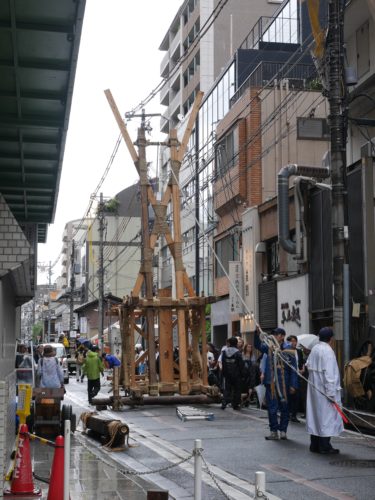
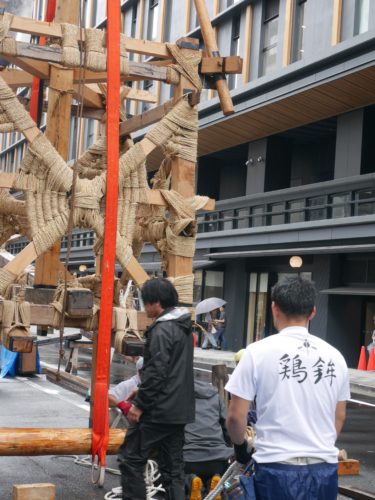
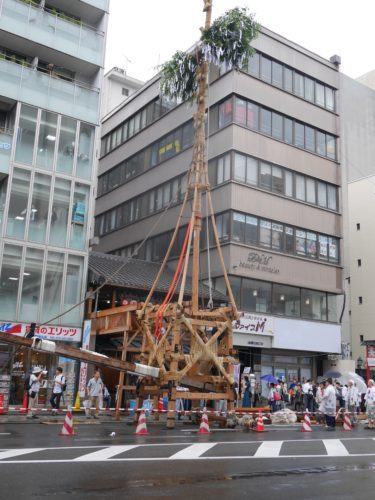

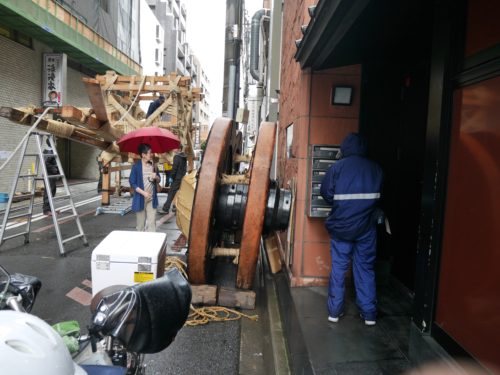
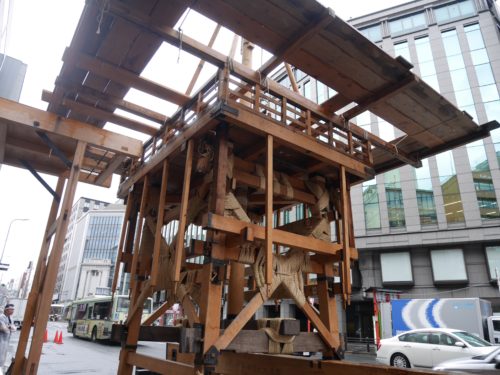
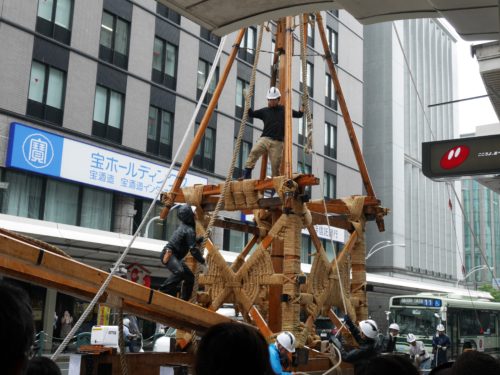
July 12-13: Beginning of pulling and carrying of floats and yama (Mae-matsuri)
From July 12 to July 17, the actual movement of the floats and mountains for the Mae-Matsuri Yamahoko Junko.
When the floats are pulled and begin to move slowly to the signal of the ondo-dori, the audience applauded unanimously.
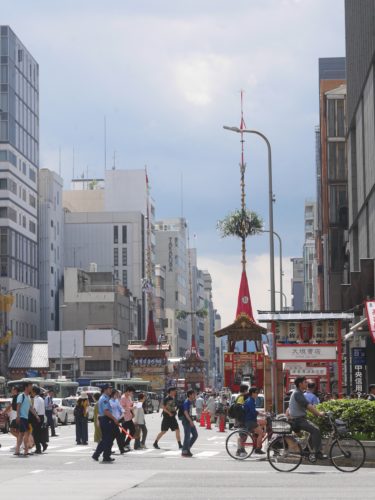
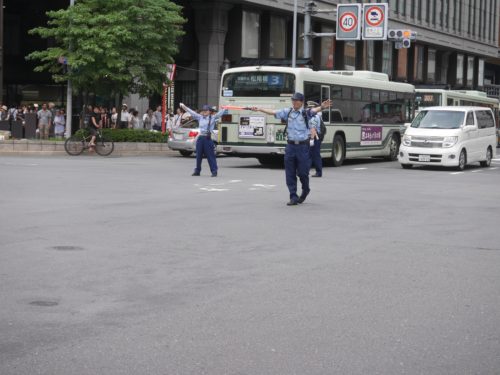

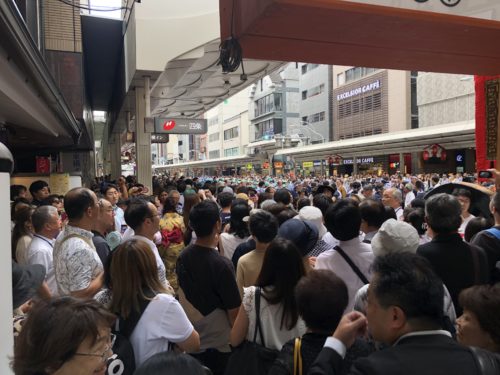
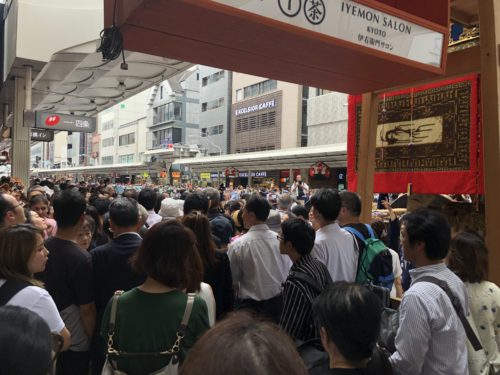
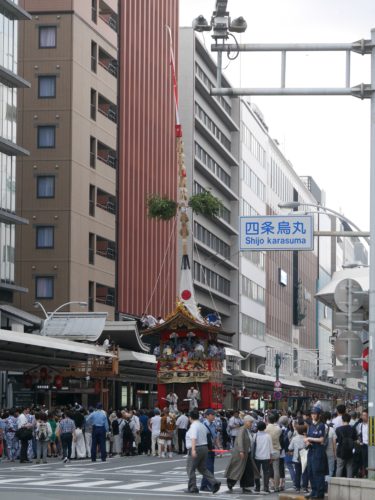


July 13: Naginatahoko Chigo Shasan(長刀鉾稚児社参)
Children are believed to be incarnations of gods, and the July 17 Yamahoko-junko begins with a child cutting the rope.
Every year, a boy of about 10 years old from a family with strong ties to Kyoto is chosen as a child.
This year, the son of the president of the famous long-established Japanese sweets store “Kogetsu” was chosen.
On July 13, he will make a shrine visit to Yasaka Shrine to officially become an incarnation of God.
From this day until the end of the Yamaboko procession on July 17, they will no longer be on the ground, but will travel on horses or on the shoulders of strong men called goriki. They will no longer be able to touch the children directly.
Currently, the only float in which children ride is the naginohoko float.
Only men are allowed to ride on the naginatahoko floats, which lead the Yamaboko procession.
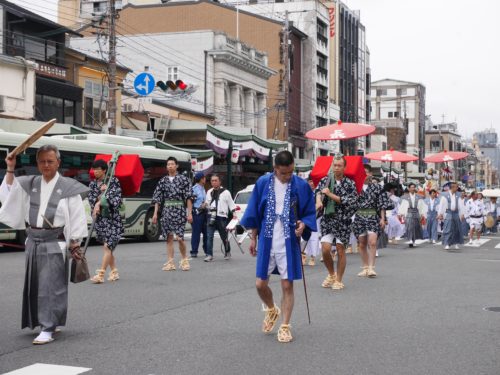

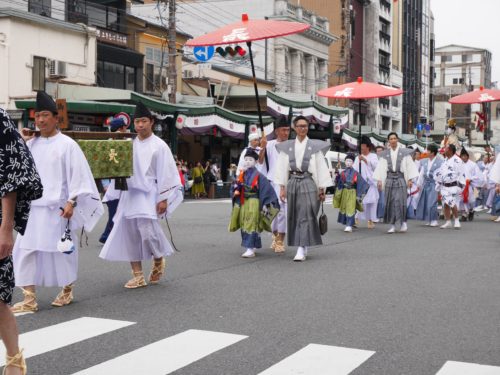
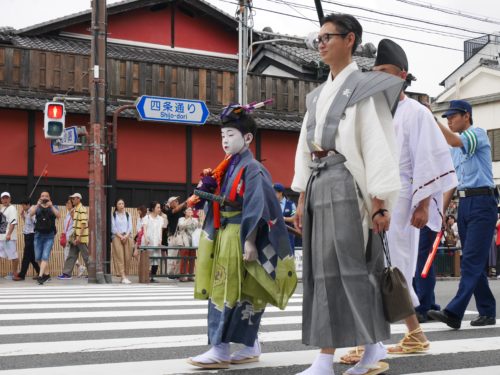


July 14-16 Yoiyama
From July 14 to 16, the lanterns of the erected floats and mountains will be lit.
You can actually ride on the floats that have been erected.
On the 15th and 16th, the area around Shijo Dori and Karasuma Dori will be a pedestrian paradise, filled with people.
If you want to see the floats in person, it is best to see them during the daytime, and if you want to take pictures and enjoy the festival, it is best to see them after the sun goes down.

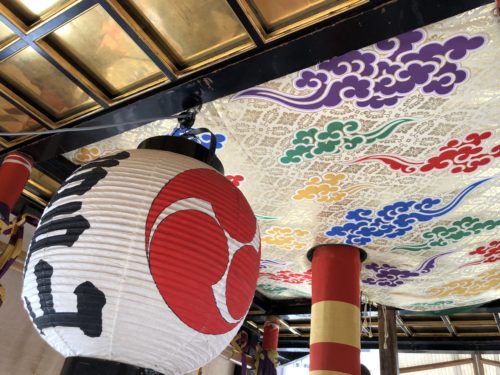
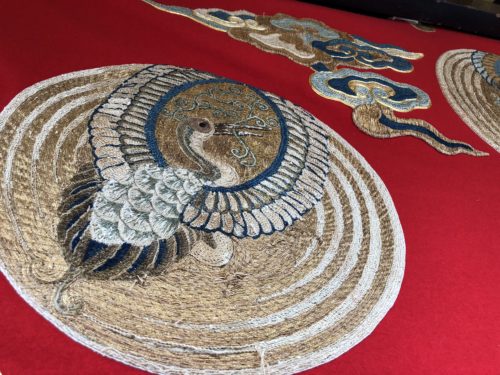
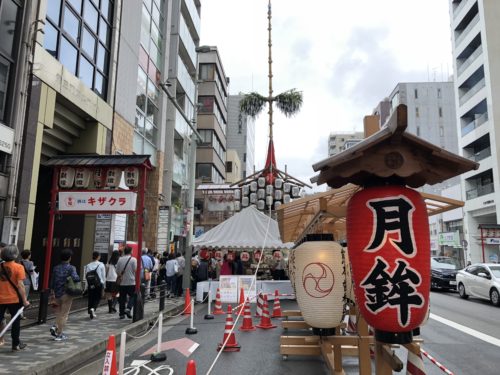
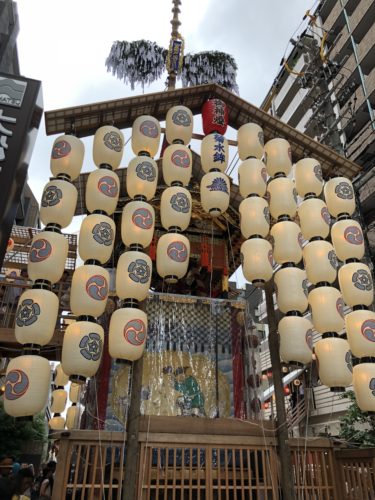
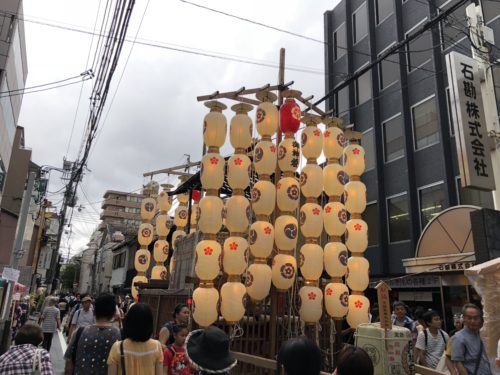
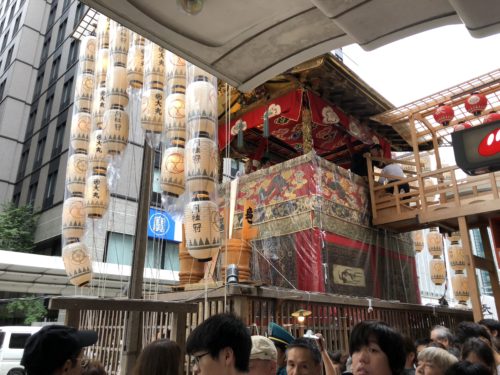
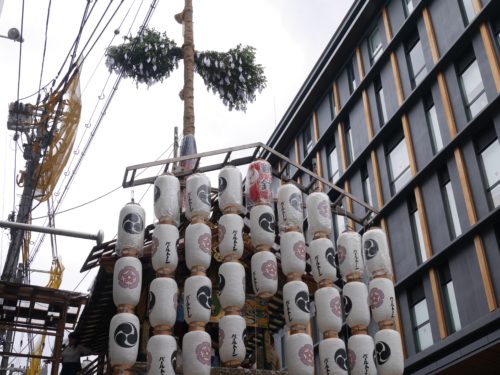

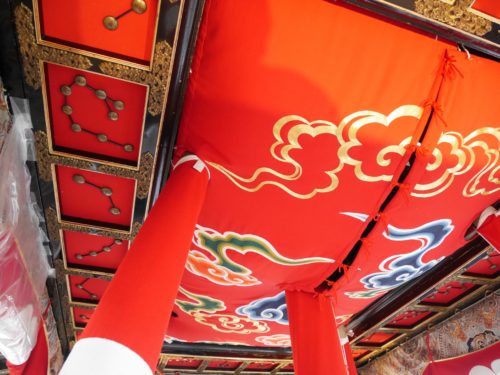
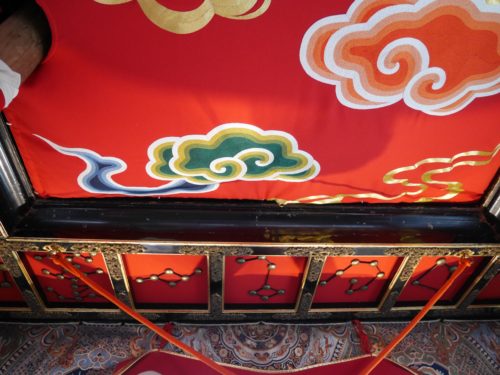
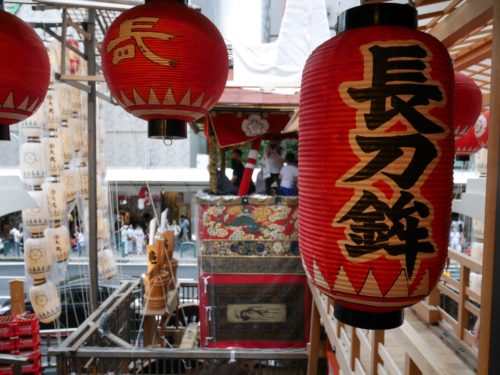
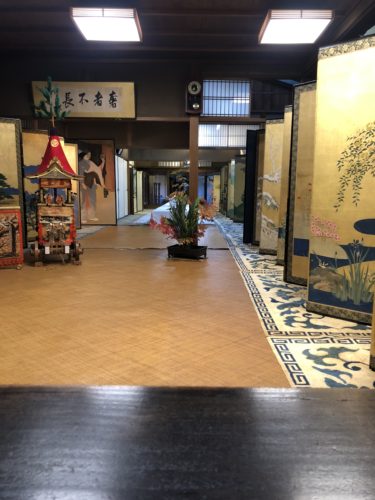
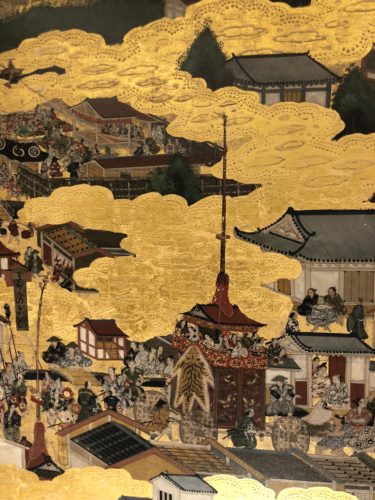
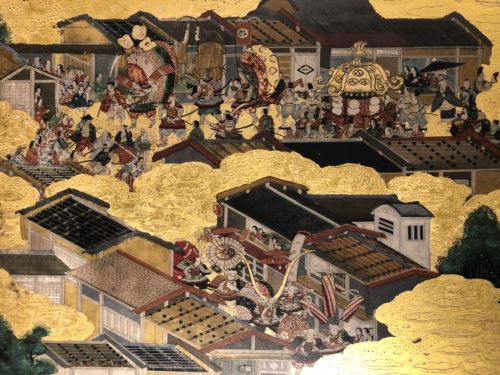
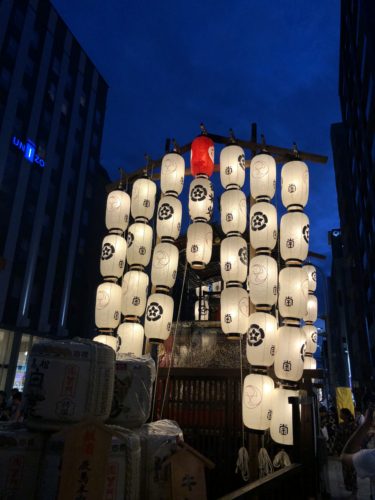

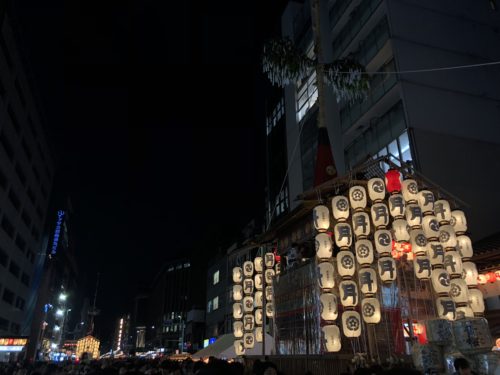
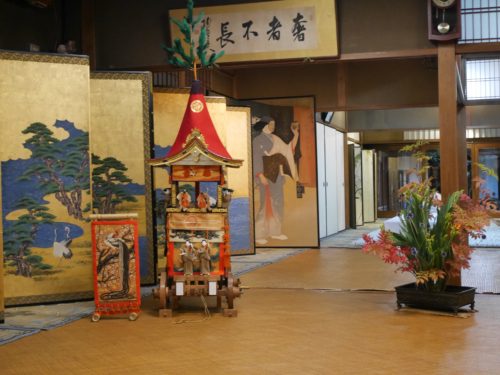
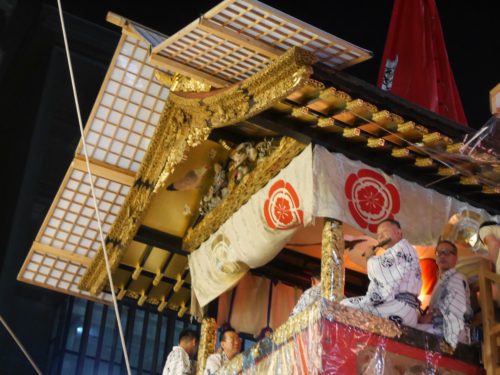
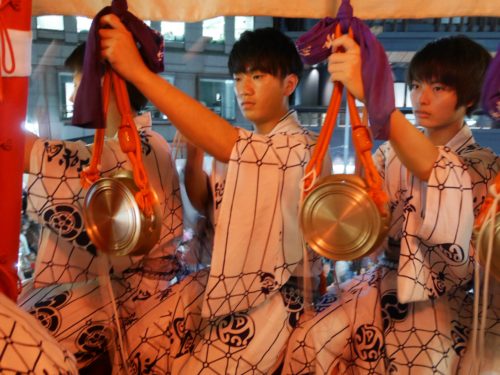

July 17: Yamaboko Junko (float parade) at the Mae-matsuri Festival
The Mae-Matsuri Yamaboko Junko begins at Shijo-Karasuma.
The Yamaboko procession starts from Shijo-Karasuma and heads east toward Yasaka Shrine, then north from Shijo-Kawaramachi.
From Kawaramachi-Oike, the procession heads west in the direction of Nijo Castle. The procession continues until Shinmachi Oike.
At Shijo-Kawaramachi and Kawaramachi-Oike, the procession of Yamaboko floats is held to change the direction of the floats.
Tsuji-kairo is one of the highlights of the Yamaboko Junko, and is full of power.
The Maesai Yamaboko Junko is the highlight of the Gion Festival. On this day, many people gather along the route to catch a glimpse of the procession.
This year, the day of the Yamaboko procession was sunny and we watched it under the blazing sun.
If you are going to see the procession, be sure to bring a hat and plenty of water.
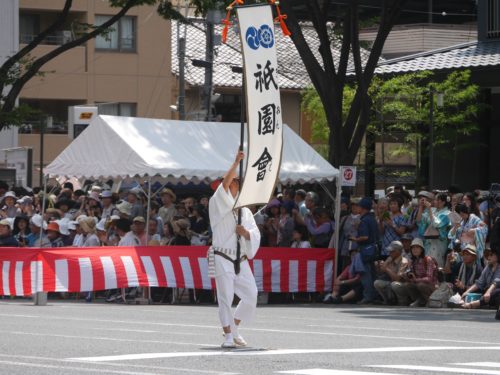
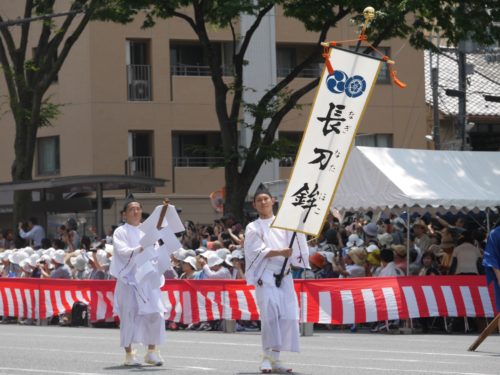


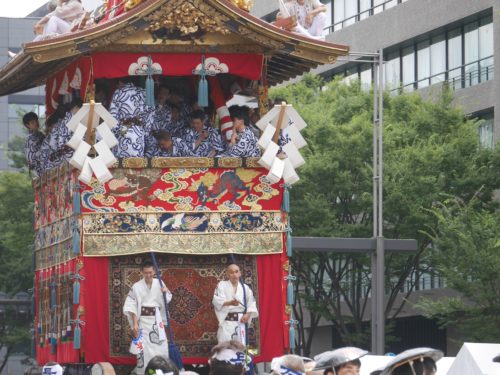
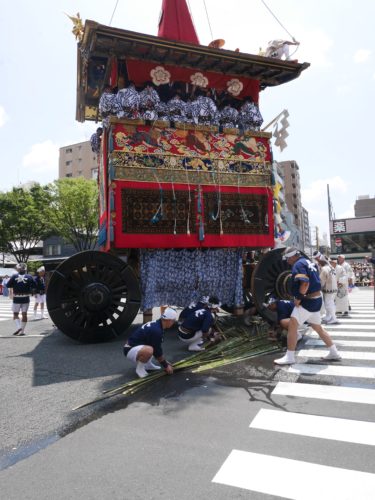
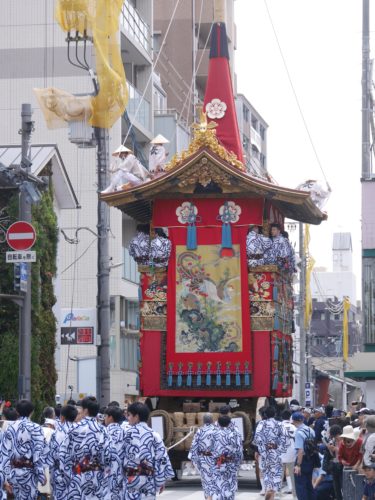
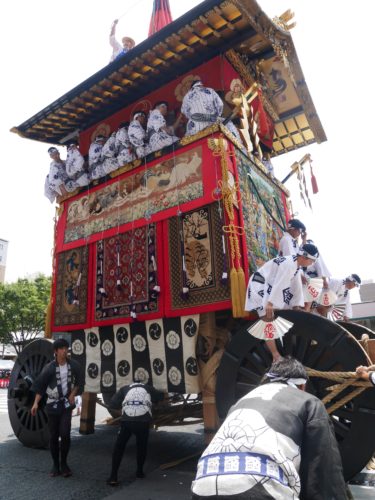
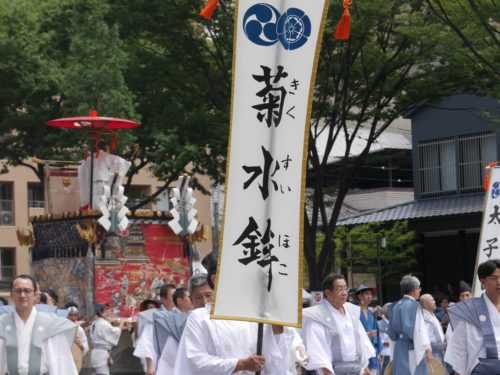

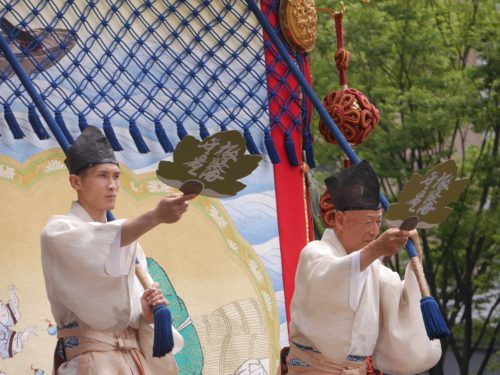

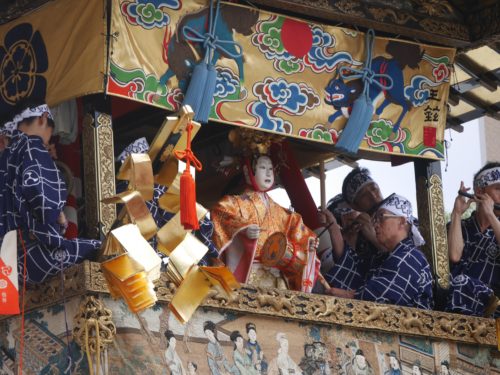
July 18-21 Yamahokotate (Ato Matsuri)
Like the Yamahoko-ken of the previous festival, it takes place between July 18 and 21.
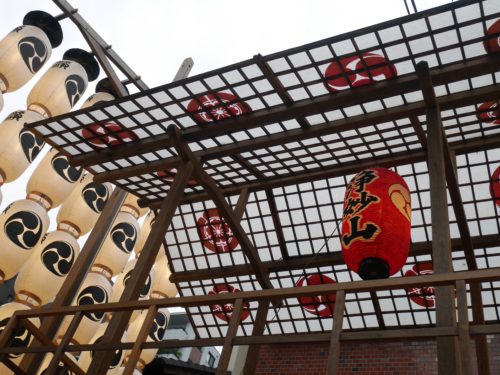
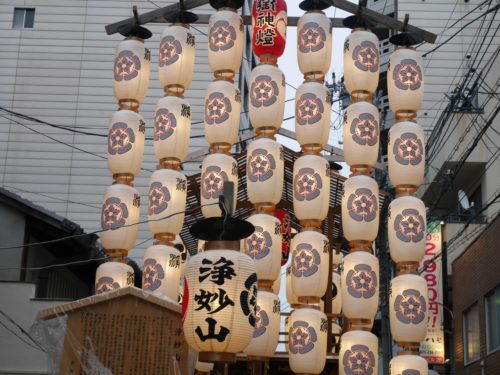

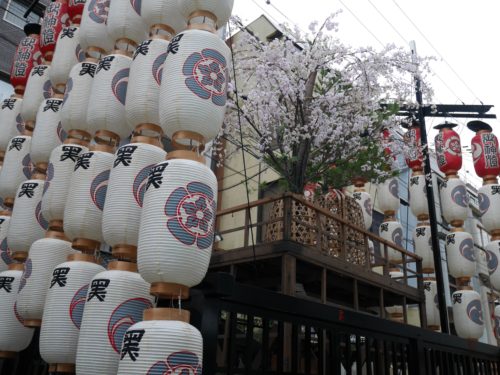
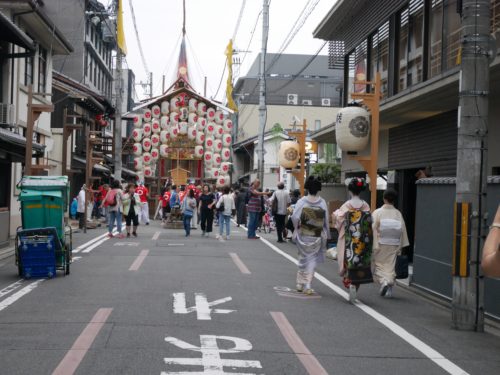



July 24: Yamaboko Junko (halberd procession) at the Ato Matsuri
The Yamahoko-junko procession of the Later Festival runs in the reverse direction of the route of the Yamahoko-junko procession of the Former Festival.
It starts at 9:30 in the morning.
On this day, the road was not tightly regulated like in the Mae Festival, and in some places, the floats were waiting at traffic lights.
However, there were still a lot of people to see the festival on this day, even though it was a weekday morning.
It was a downpour on July 23rd, but I could not believe it. I wonder if God made it sunny.
Thoughts on the 2019 Gion Festival
I moved to Kyoto last year and this year I am in full swing? I participated in the Gion Festival and had many experiences.
What I learned from participating in the festival is that it is really hot during the Gion Festival!
Frequent hydration and cafe breaks are a must (lol).
During Yoiyama, garbage collection boxes and temporary restrooms were set up in the city, which really helped.
There are many events in Kyoto during the month-long Gion Festival, such as Yamahoko-junko and Yamahoko-ken.
As a person involved in tourism, I would like to use my experience to help visitors enjoy Kyoto even more.
I am planning to write another article about the Gion Festival, so I hope you will read it.
Thank you for reading to the end.
![Useful information for sightseeing in Kyoto [Kyoto Mame-Techo]](https://kyoto-note.com/wp-content/uploads/2023/04/京都まめ手帖11.png)
